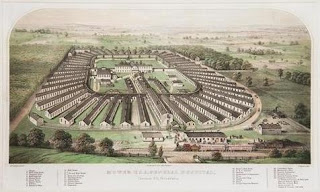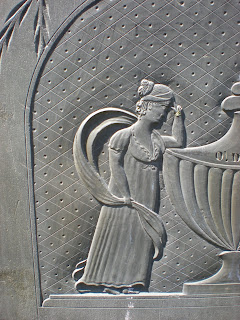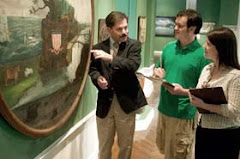A true peaceable kingdom is much more than the sum of its parts. Visitors to the
Fenimore Art Museum have for decades admired our two iconic paintings by the Quaker artist Edward Hicks (the earlier version, ca. 1825-30, depicted above), both depicting the artist’s vision of the Biblical prophecy in Isaiah that was central to Quaker belief. What most people don’t realize is how Hicks put together his unique image from available sources to create a unique whole.
Hicks had a complicated childhood. He was born in bucks County, Pennsylvania in 1780 into an Anglican family that was pro-British during the Revolutionary War. His father was forced into seclusion because of these leanings, and his mother died in 1781. Edward was sent to board with Quakers David and Elizabeth Twining in Newtown, where he served an apprenticeship with a coach maker when he turned 13. There he learned to paint in a stylized, sign painter’s style that would influence his whole body of work. He also became a respected Quaker minister with the Middletown Monthly Meeting.
In the early 1820s Edward developed his idea for painting an homage to Quaker beliefs. He adapted a popular engraving from the Bible, Richard Westall’s
Peaceable Kingdom of the Branch (published in 1815, abvoe), into an American landscape, and incorporated a lettered border that showcased his sign painting experience. The verse on the border was paraphrased from Isaiah 11:6-9 (which the Westall engraving was meant to illustrate), which reads, in part, “The wolf will live with the lamb, the leopard will lie down with the goat, the calf and the lion and the yearling [a] together; and a little child will lead them.” Hicks’s version is cleverly rhymed, as you can see in the early Peaceable Kingdom our Museum is fortunate to own. It mentions all of the animals alluded to in the Biblical verse.

Hicks also throws in an extra detail. The last two lines of his verse read: “When the great PENN his famous treaty made,/With indian chiefs beneath the elm- trees shade.” William Penn (1644 – 1718) was a hero to Quakers for his establishment of religious tolerance, equality of men and women, and fair treatment of Native Americans. To Hicks, Penn had created a Peaceable Kingdom on earth, and thus his inclusion here was warranted.
But Edward went further than mentioning Penn: he actually put him in the picture making his famous treaty with the Lenni Lenape, or Delaware Indians, in 1682. To create this image, Edward looked to a popular engraving, found in many Quaker households, of Benjamin West’s 1771 painting of Penn’s Treaty (the original painting is in the Pennsylvania Academy of Fine Arts). You can tell that Edward used the engraving as his source because the image is reversed from the original painting.
The result is a potent and beautiful summation of Quaker beliefs, delivered as eloquently as any sermon. IWe perhaps learn as much about the artist from his inscription on the reverse of our
Peaceable Kingdom, where he writes, “Edw. Hicks To his adop[t]ed sister Mary Leedom & her Daughters didicates this humble peiee of his art of Painting.” It is true that Edward had a great many gifts, generosity among them as can be seen by the fact that he gave this painting to a loved one, but it is his humility that I think defines him more. Hubris is antithetical to a harmonious world.







.jpg)
.jpg)
+-+cropped.jpg)



















































